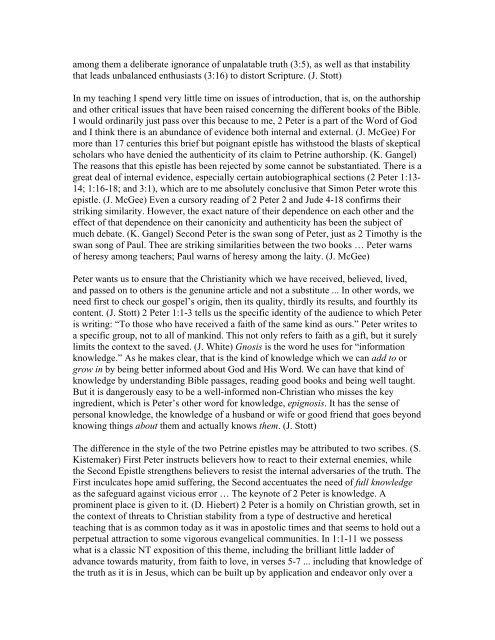2 Peter - Verse-by-Verse Biblical Exegesis
2 Peter - Verse-by-Verse Biblical Exegesis
2 Peter - Verse-by-Verse Biblical Exegesis
Create successful ePaper yourself
Turn your PDF publications into a flip-book with our unique Google optimized e-Paper software.
among them a deliberate ignorance of unpalatable truth (3:5), as well as that instability<br />
that leads unbalanced enthusiasts (3:16) to distort Scripture. (J. Stott)<br />
In my teaching I spend very little time on issues of introduction, that is, on the authorship<br />
and other critical issues that have been raised concerning the different books of the Bible.<br />
I would ordinarily just pass over this because to me, 2 <strong>Peter</strong> is a part of the Word of God<br />
and I think there is an abundance of evidence both internal and external. (J. McGee) For<br />
more than 17 centuries this brief but poignant epistle has withstood the blasts of skeptical<br />
scholars who have denied the authenticity of its claim to Petrine authorship. (K. Gangel)<br />
The reasons that this epistle has been rejected <strong>by</strong> some cannot be substantiated. There is a<br />
great deal of internal evidence, especially certain autobiographical sections (2 <strong>Peter</strong> 1:13-<br />
14; 1:16-18; and 3:1), which are to me absolutely conclusive that Simon <strong>Peter</strong> wrote this<br />
epistle. (J. McGee) Even a cursory reading of 2 <strong>Peter</strong> 2 and Jude 4-18 confirms their<br />
striking similarity. However, the exact nature of their dependence on each other and the<br />
effect of that dependence on their canonicity and authenticity has been the subject of<br />
much debate. (K. Gangel) Second <strong>Peter</strong> is the swan song of <strong>Peter</strong>, just as 2 Timothy is the<br />
swan song of Paul. Thee are striking similarities between the two books … <strong>Peter</strong> warns<br />
of heresy among teachers; Paul warns of heresy among the laity. (J. McGee)<br />
<strong>Peter</strong> wants us to ensure that the Christianity which we have received, believed, lived,<br />
and passed on to others is the genunine article and not a substitute ... In other words, we<br />
need first to check our gospel’s origin, then its quality, thirdly its results, and fourthly its<br />
content. (J. Stott) 2 <strong>Peter</strong> 1:1-3 tells us the specific identity of the audience to which <strong>Peter</strong><br />
is writing: “To those who have received a faith of the same kind as ours.” <strong>Peter</strong> writes to<br />
a specific group, not to all of mankind. This not only refers to faith as a gift, but it surely<br />
limits the context to the saved. (J. White) Gnosis is the word he uses for “information<br />
knowledge.” As he makes clear, that is the kind of knowledge which we can add to or<br />
grow in <strong>by</strong> being better informed about God and His Word. We can have that kind of<br />
knowledge <strong>by</strong> understanding Bible passages, reading good books and being well taught.<br />
But it is dangerously easy to be a well-informed non-Christian who misses the key<br />
ingredient, which is <strong>Peter</strong>’s other word for knowledge, epignosis. It has the sense of<br />
personal knowledge, the knowledge of a husband or wife or good friend that goes beyond<br />
knowing things about them and actually knows them. (J. Stott)<br />
The difference in the style of the two Petrine epistles may be attributed to two scribes. (S.<br />
Kistemaker) First <strong>Peter</strong> instructs believers how to react to their external enemies, while<br />
the Second Epistle strengthens believers to resist the internal adversaries of the truth. The<br />
First inculcates hope amid suffering, the Second accentuates the need of full knowledge<br />
as the safeguard against vicious error … The keynote of 2 <strong>Peter</strong> is knowledge. A<br />
prominent place is given to it. (D. Hiebert) 2 <strong>Peter</strong> is a homily on Christian growth, set in<br />
the context of threats to Christian stability from a type of destructive and heretical<br />
teaching that is as common today as it was in apostolic times and that seems to hold out a<br />
perpetual attraction to some vigorous evangelical communities. In 1:1-11 we possess<br />
what is a classic NT exposition of this theme, including the brilliant little ladder of<br />
advance towards maturity, from faith to love, in verses 5-7 ... including that knowledge of<br />
the truth as it is in Jesus, which can be built up <strong>by</strong> application and endeavor only over a









